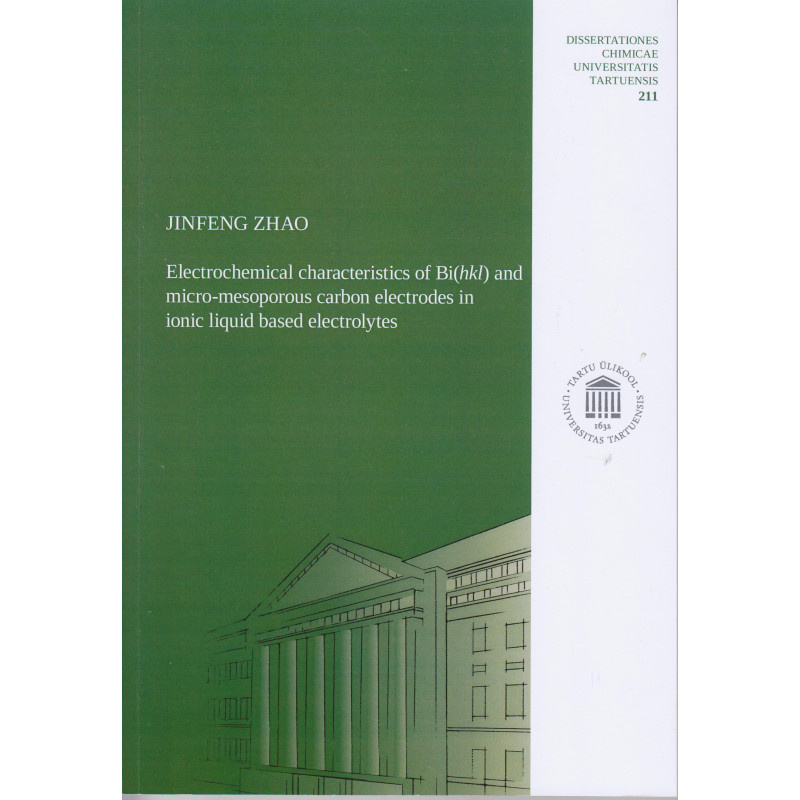



Tartu : University of Tartu Press, 2022
134 p.
ISBN: 9789949038961
Paperback, in very good condition.
Theses(doctorate):Recently, the energy crisis has become more and more serious. Thus, it is important to accelerate energy upgrading and establish the growth of new energy economics. As one of the carriers of global energy transformation, the development of electric vehicles may contribute to establishing the electrification of society and the transformation of industrial structure. However, the rapid development of electric vehicles still represents several challenges and limitations, such as the charging capacity of power sources involving batteries and supercapacitors. With the continuous iteration in the technological progress of battery and supercapacitor materials, efforts have been made to develop high-performance electrochemical energy storage devices. The electrochemical energy storage process, in principle, occurs at the electrode-electrolyte interface. It is of great significance to study the electrochemical behavior at the interface. Therefore, the electrochemical behavior and energy storage characteristics of the electrode-electrolyte interfaces were studied in this work, aiming to achieve high capacitance performance. Ionic liquids (ILs) composed of anions and cations can show high thermal, chemical and electrochemical stability. This work focused on the electrochemical characteristics of the pure IL and IL salt mixtures. Regarding electrode materials, Bi(hkl) and micro- and mesoporous carbon electrodes were studied. As an excellent alternative electrode material for traditional mercury electrodes, bismuth electrode with low toxicity has been widely studied in the Department of Physical Chemistry, University of Tartu. The capacitance-potential curves of pure IL and IL salt mixtures at the Bi(111) electrode were discussed in this work, mainly conducted by the cyclic voltammetry and electrochemical impedance spectroscopy methods. The capacitance peaks of capacitance-potential curves suggest that the specifically adsorbed anions (i.e., I‾ and Br‾) can increase the capacitance. Additionally, electrochemical characteristics of water-contained ILs at Bi(hkl) electrodes were studied. The capacitance-potential curves have seen anomalous capacitance peaks due to the specific interaction between water and anions. Interestingly, small amounts of adsorbed water molecules do not affect the electrochemical stability potential range of the base electrolyte but contribute to the increase of capacitance. According to the equivalent circuit modeling fit of experimental impedance data, the kinetics of surface processes (mass transfer and faradaic characteristics) were shown in the resistance-potential curves. To characterize the surface structure of the interface in a nanoscale, in situ scanning tunneling microscopy measurement was applied to image the surface structure of electrodes in IL within the potential range applied. Results found that the highly ordered structures on Bi(111) and Bi(011 ̅) planes were recorded relating to the strongly adsorbed anions consistent with electrochemical results. Since the specifically adsorbed halide ions (Br‾, I‾) at the Bi(111) electrode can increase the capacitance at the interface, it is assumed that such halide ions could help improve the capacitance performance of supercapacitors. The pure IL, IL salts mixture containing halide ions and IL salts mixture containing alkali ions were applied to impregnate the micro- and mesoporous carbon electrodes of supercapacitors. Compared to the pure IL treated supercapacitor, supercapacitors treated with halide salt mixtures showed higher capacitance. In contrast, alkali salt mixtures did not improve the capacitance performance of the supercapacitor. Moreover, supercapacitors treated with halide (positive electrode) and alkali (negative electrode) salt mixtures showed consistently high capacitance, suggesting an effective doping methodology by symmetrically stabilizing both electrodes. According to the equivalent circuit modeling fit of experimental impedance data, the enhanced capacitances are attributed to the pseudocapacitive effect originating in the specifically adsorbed and redox-active halide ions within and near the carbon pores.
Series: Dissertationes chimicae Universitatis Tartuensis ; 211. Summary in Estonian